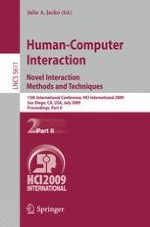The 13th International Conference on Human–Computer Interaction, HCI Inter- tional 2009, was held in San Diego, California, USA, July 19–24, 2009, jointly with the Symposium on Human Interface (Japan) 2009, the 8th International Conference on Engineering Psychology and Cognitive Ergonomics, the 5th International Conference on Universal Access in Human–Computer Interaction, the Third International Conf- ence on Virtual and Mixed Reality, the Third International Conference on Internati- alization, Design and Global Development, the Third International Conference on Online Communities and Social Computing, the 5th International Conference on Augmented Cognition, the Second International Conference on Digital Human Mod- ing, and the First International Conference on Human Centered Design. A total of 4,348 individuals from academia, research institutes, industry and gove- mental agencies from 73 countries submitted contributions, and 1,397 papers that were judged to be of high scientific quality were included in the program. These papers - dress the latest research and development efforts and highlight the human aspects of design and use of computing systems. The papers accepted for presentation thoroughly cover the entire field of human–computer interaction, addressing major advances in the knowledge and effective use of computers in a variety of application areas.
